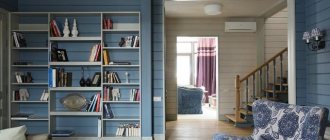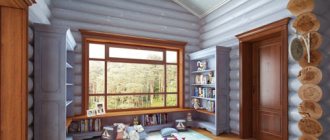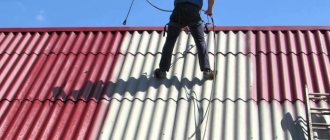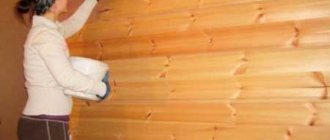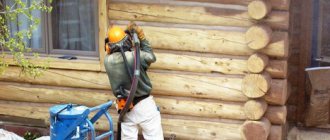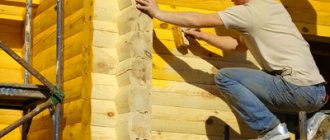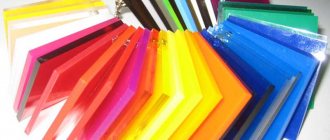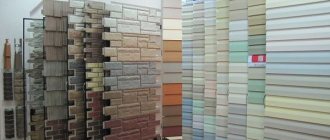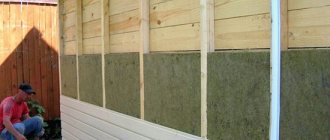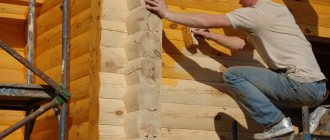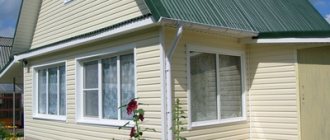Is it possible to paint a house in winter? This question will seem strange to many, since any professional decorator will say that painting can only be done in warm weather, and almost every can of paint indicates that it should be used at positive temperatures. Nevertheless, situations when it becomes necessary to paint the facade of a house in winter do not happen so rarely. Undoubtedly, the best time to paint the exterior walls of a house is late spring, summer and the first half of autumn, but despite this, houses are still painted in winter, and quite successfully. However, before you start painting a log house or wooden bathhouse, you need to know a number of nuances that are present in this work, and also take into account that only professionals can do really high-quality painting of a wooden house.
Features of external and internal painting in winter
The vast majority of paints intended for exterior use can be used at above-zero temperatures. Manufacturers recommend performing painting work at temperatures not lower than +5 degrees.
Today there are so-called “winter” paints that allow you to paint the surface at an outside temperature of -10 degrees. The drying time of such paints is much longer than conventional ones. For example, if ordinary paint dries in a day in warm weather, then winter paint will take at least three days to dry.
When painting wooden surfaces, winter paints should be used with extreme caution. Wood is a special material; it always contains a certain percentage of moisture in its fibers. At low temperatures, moisture turns into ice, which prevents paint and varnish materials from entering the wood. Therefore, you can paint a wooden house only when the temperature of the surface to be painted reaches positive values.
As for painting the interior, we can safely say that it is possible to paint the inside of a house in winter. But only if the building is heated, in unheated buildings it is necessary to create an optimal temperature regime. We will tell you how to do this below.
For interior spaces, it is best to use water-soluble dyes, as they are the safest and most environmentally friendly. They do not emit odor and do not contain toxins, so people can safely stay in a painted house.
If you use organic-based paint, which has an unpleasant odor and contains harmful components, it is necessary to ventilate the room well after painting, and if possible, leave it until the paint has completely dried.
Maximum temperature limits for paints
Before carrying out work, you need to make sure that the established temperature regime is suitable for the purchased paint.
Previously, the minimum temperature at which it was allowed to paint the walls of residential and commercial buildings was +5 ° C. Now, however, dyes are being produced that can be used at zero temperatures and even in severe frost, down to -30 ° C. The upper limit at which painting can be done is considered to be +40 °C.
Features of painting wood in rainy weather
Traditionally, the facade of a wooden house is painted in dry weather with wood moisture content not exceeding 20%.
Before painting, a log house must be sanded. If you sand in the rain, lint will appear on the surface of the logs or beams, which will not allow you to make the surface smooth. Sanding and painting a house in the rain, and especially in a downpour, is not recommended. When painting wet wood, the paint will lie unevenly and may wrinkle and crack when drying. In addition, whitish spots may appear in those places where water drops have fallen, so the surface will have to be repainted.
It is advisable to start painting one or two days after the rain, so that the surface of the logs is completely dry. If the rainy season has begun in your region, and you urgently need to paint the outside of a wooden house, you need to cover the facade with an awning or polyethylene before painting.
Recommendations for better drying
To make frost-resistant metal paints dry faster, you can use devices that heat the air over a short distance. Not only special devices are suitable, but also household appliances (for example, a hair dryer).
It is necessary to pre-prepare the surface. You will have to remove the previous coating from it. Then the metal product is processed with special devices.
Suitable:
- sandblasting machine;
- sandpaper.
If there are irregularities, use putty.
It will not work in rainy or snowy weather. Precipitation will prevent winter metal paint from drying.
You only need to work with dry and clean material. Dust, dirt and mold are removed with a brush.
If the work is carried out in an unheated room, you can speed up the drying process using a portable heater; the paint dries faster when exposed to heat.
How to paint in winter
As mentioned above, painting a log house or bathhouse in winter can only be done when the surface of the logs has a positive temperature.
In this case, the ice crust that has bound the wood fibers will melt, and the wood will again be able to absorb paint well. To achieve positive temperatures and protect the tree from snow, a thermal circuit is built around the house. This is done as follows:
- scaffolding is installed along the perimeter of the building;
- the outside of the scaffolding is covered with an awning or polyethylene;
- the space between the wall of the house and the awning is heated using heat guns until the temperature inside the circuit reaches positive values.
When installing heat guns, fire safety requirements must be observed. Heaters should be located not inside, but outside the circuit at a safe distance.
To check whether the wood is ready for painting, you need to stick a piece of tape on it. If after 24 hours there is no condensation on it, the wood can be painted.
Please note that in winter only paint can be applied to a wooden surface; wood cannot be varnished in winter, since when it dries the varnish shrinks and the coating will crack.
The interior of the house can also be painted only at positive temperatures. Unheated rooms must be heated before applying coloring agents. You can also use heat guns for this.
Frost-resistant paints for rust
Infrazim-Antikor is suitable for painting rusted structures. This paint is used in the range -20...+30 °C. Humidity should not exceed 80%. The composition is simultaneously a rust converter, a corrosion-preventing primer and an environmentally resistant decorative enamel. You can purchase glossy or matte paint. As for the palette, paintwork materials are available in white, gray, beige, cream, red, green, light green, light blue, blue, ocher, brown, yellow, orange, black and red-brown.
Primer enamel XB-0278 can be used for outdoor work at temperatures ranging from -10 to +25 °C. This product is applied to metal with rust and traces of scale that cannot be removed.
Primer-enamel for rust “Spetsnaz” is used to treat rusted steel and cast iron products in order to prevent the occurrence of corrosion. The composition will also protect the metal from aggressive gases and fumes during production. "Spetsnaz" can be used for repair painting of car parts. They work with paintwork materials at sub-zero temperatures (down to -10 °C).
Professional painting at any time of the year
carries out painting work all year round in any weather. Our specialists are highly qualified and have extensive experience in painting wooden houses.
If you need to paint a wooden house or bathhouse, contact our company. We will create ideal conditions for painting in winter. For this we have everything necessary: specialized equipment and tools, qualified craftsmen, professional knowledge, experience and work skills.
Regardless of the season and weather conditions, our craftsmen perform work at a high professional level, strictly according to technology and in compliance with the agreed deadlines. We provide a guarantee for all work.
You can order a visit from a specialist or contact us with a question you are interested in, using any method using the coordinates located on the “Contacts” page.
Calculate the cost of painting and insulating your home right now
Select types of work:
Select materials:
Primer enamel Akromet
Designed for painting surfaces made of carbon and stainless steel, aluminum, galvanized, concrete surfaces, does not require preliminary priming.
Primer enamel is developed on the basis of an acrylic binder, due to which it has a number of unique properties: - application at temperatures from +5°C to -15°C - high adhesion to non-ferrous metals - high protective properties - resistance of the coating to temperatures from +140°C to +140 ° C -40 ° C
Additional tips and tricks
To choose a heat-resistant composition, you need to pay attention to the quality characteristics of the surface intended for processing. In addition, one should take into account what result is planned to be obtained. You should not expect that heat-resistant compounds can offer a varied palette.
Tips and tricks:
To apply the next layer, you must wait until the previous layer has dried. The packaging of the composition indicates the approximate drying time. Technologists advise adding a margin of 10 minutes to this indicator yourself.
Do not work outdoors in rain or snow. Weather conditions will not contribute to creating a smooth finish. If the air temperature has dropped, aerosol cans should not be used. The spray hole becomes clogged with pigment particles and cannot create an even layer.
Source
Excessively high temperatures can cause defects in the car's paint.
Increased temperatures can also harm the bodywork. Therefore, the use of a hair dryer during work is not allowed. The main condition for high-quality coating is the same temperature of both the environment and the metal with the paint. When a layer of putty is present, this also applies to it.
If this condition is not met, the consequences are negative:
- Over time, the paint layer begins to swell and peel off.
- The service life of the coating is reduced.
- If a layer of varnish is applied on top, it quickly loses its shine.
General temperature requirements for paint and varnish work
There are certain conditions for each type of paint and varnish product. Compliance with the conditions allows you to expect strong adhesion of the compositions to the surface.
Reference! Oily paints take the longest to dry. The drying period is 4-6 days.
Primer
Facade painting
The façade often has to be painted in winter. To prevent damage to the surface, a special type of frost-resistant paint is used. A prerequisite for painting facades is high-quality cleaning. All irregularities and nicks must be repaired in advance. A layer of paint will adhere well to a dry surface sealed with soil.
Brick painting
Brick cannot be coated with a layer of paint immediately after masonry is completed. Small particles that begin to peel off from the coating will lead to cracking of the entire layer. It is recommended to pause after completing the masonry. The minimum period is 12 months. The brick must be carefully primed with a special compound using rollers and spatulas. The finishing layer will lay on the ground without difficulty.
Working with concrete in winter
To paint a concrete surface, it is necessary to wait a year after concreting. The dust that separates from the fill must disappear. It is not recommended to paint a concrete surface in winter. If necessary, the cleaned surface is painted with frost-resistant paint in one layer.
Painting metal in winter
Metal can be painted with thermal compounds with special markings. At subzero temperatures, iron does not release excess moisture, so the composition fits well on a flat surface. Before painting, the metal is cleaned of traces of rust and various irregularities. The next stage of cleaning is degreasing. After this, the metal area is rinsed with clean water and allowed to dry. Large surfaces are covered with a roller, small areas are painted with brushes.
Painting wooden surfaces
Wooden surfaces cannot be painted in winter. Drops of moisture accumulate between the fibers of the tree, they freeze in the cold, and when it warms up they become watery. The layer made in winter will become weak and crack when it gets warmer.
The condition for creating a strong grip is good warm weather not lower than +10 degrees. To facilitate the adhesion process, the surface can be heated from the inside with a hairdryer or exposed to the sun.
How to thin the paint?
One of the most important conditions for comfortable and economical application of water-based paint is to bring it to the required viscosity levels. Paint that is too liquid will run off and will not be able to properly paint the surface and fill existing small unevenness or roughness, while paint that is too thick will have a very high consumption of material per square meter. surface meter. In addition, too thick a layer of paint can lead to peeling of the material.
So what should you use to dilute the paint if its consistency requires it? The easiest method of dilution is, of course, the most ordinary water. There are also special solutions for dilution, but water is the most accessible and simplest material.
In order to dilute the paint, you need to take a clean container, the size of which will depend on the parameters of the surface and the amount of paint that will be needed for painting. If paint consumption is high, you can dilute it directly in the factory container.
The dilution process itself is extremely simple: you need to gradually add additional water to the paint, while the mixture must be thoroughly mixed. It is best to mix the components with the most suitable device for this - a wooden stick. The proportions of dilution of the emulsion with water will be determined by the initial thickness of the paint.
A special recipe exists for diluting heavily thickened paint, which has already acquired the consistency of a paste. Here the same water that needs to be diluted will help make it suitable for work again. Only under these circumstances does it need to be heated.
Sometimes, to obtain a colored water-based emulsion of the required consistency, there is no need to dilute it with water - it is enough to carry out the tinting process. The procedure will be similar to that described earlier.
- In clean dishes you need to add the amount of paint necessary to paint the entire selected area, otherwise it can be extremely difficult to match the color with additional tinting.
- Next, all this paint needs to be mixed until smooth with a clean stick or using a construction mixer.
- Without ceasing to stir, you need to start introducing the dye drop by drop. These actions should be continued until the paint acquires the desired shade.
In addition, during the tinting process you can add a special pigment that will help make the selected paint pearlescent. This action will help achieve a very interesting final result.
Recommendations for painting surfaces in cold weather
The rules for using primer and paint in cold air mention mandatory surface preparation. You cannot use coloring materials without certain actions:
- clean the work area from old coating,
- treat the surface with a sandblasting machine, sandpaper or other convenient method,
- fill the unevenness with putty,
- if the technology requires, apply priming (the walls need to be primed if this is indicated by the manufacturer on the paint packaging).
You cannot work if it is raining or snowing - you need to wait for normal weather to arrive. Painting should be done with a roller or brush, but it is better to forget about the spray gun - its nozzle will quickly become clogged.
The most important thing is to make the surface clean and dry. You should also bring the enamel to the desired viscosity. Usually water-based paints are used, which are diluted with water. It is necessary to remember that alkyd materials sharply increase their viscosity in the cold, and do not forget to dilute and warm them up in time.
Primer work
In winter, use a primer that is resistant to low temperatures (frost-resistant primer). If iron is stained, special phosphating compounds are used. They can be applied over rust, as they include special anti-corrosion components. Priming provides additional protection against corrosion and increases the adhesion of the final coating.
Painting house facades
Carrying out external facade work in winter is possible if you choose the right paint. After cleaning the walls from dirt and dust, they sand them; if there are areas of old paint or mold, they are removed. Next, prime the walls with a product of the same brand as the base paint - this will improve the quality of the coating. They work with packages brought from warm places. As soon as the material begins to freeze, it is put into a warm place and another package is taken out. The second coat of paint is usually applied after 3-5 days.
Painting brick and plastered surfaces
The painting of such surfaces is no different from that of the facades of the house. It is only important not to paint immediately after finishing the masonry - the work is postponed, the minimum period is a year. If you paint right away, the coating will peel off. Surface preparation is required (cleaning with a brush to remove dirt, dust, mold). The chipped plaster is cleaned, the holes are sealed, and allowed to dry thoroughly. You can also fill deep holes with frost-resistant silicone sealant. After priming, the wall is allowed to dry for 5–7 days, then it is painted with a roller or brush.
Concrete processing
Concrete floors and walls have a porous surface. Also, the outer side of concrete products weathers faster and the coating dye loses its brightness. Painting concrete can be done a year after installation, this is necessary so that some of the concrete dust evaporates. In some cases, it is possible to paint surfaces without exposure - for example, in a workshop, warehouse, hangar.
Metal processing
In winter, you may need to paint pipes, garage walls, iron cladding of sheds, corrugated sheet fences, etc. Metal does not absorb moisture, so it does not change properties depending on the climate. For painting work, special metal compositions should be used - at sub-zero temperatures they form a strong elastic film.
Tips for painting metal in winter:
- the surface must be dry, clean, free of rust using abrasive devices,
- if there is frost, the surface is treated with a flash of a gas burner - a brush or scraper will be ineffective,
- Preliminary degreasing is carried out with isopropanol and acetone.
Painting wood
It is not recommended to paint wood, products made of fiberboard, chipboard, and lining in winter. If the house is made of wood on the outside, it is better to leave painting it until the warm season. Water accumulates between the fibers of the tree, which freezes in frost. The structure of the material expands, and the paint applied on top seals it in this state along with the ice. After thawing, the water begins to push out the paint, the latter cannot withstand it and bubbles. The wood also begins to rot under the enamel.
If staining is urgently needed, a test is done first. Apply a wide strip of tape to the surface, leave it for 2 days, then remove it. If there is condensation on the tape, painting is not done. With a dry strip, painting can be done after preliminary priming.
Organosilicate composition OS-12-03.
Designed for anti-corrosion painting of building structures made of low-carbon steels and reinforcement of reinforced concrete products, operated in atmospheric conditions of high humidity and temperature changes from – 60 ° C to + 300 ° C (above-ground gas ducts, technological tunnels, chimneys), as well as for decorative painting of porous surfaces of industrial buildings and structures (concrete, reinforced concrete, brick, plastered, wooden and ceramic surfaces).
Application temperature: from – 20°С to + 35°С.
What is the best way to whiten trees?
There are three options for whitening fruit trees in the fall from diseases and pests: water-based paint, water-dispersed paint or lime mortar. The first two options are more economical: most likely, the whitewash will not need to be renewed in the spring. To make the paint stick better, it is diluted with water (for 1 liter of paint - 5 liters of liquid). The paint must indicate that it can be used for gardening. If a substance is intended exclusively for construction work, it cannot be used.
Subtleties of application
Paint application, like any other stage of the painting process, has its own subtleties and rules.
So, regardless of the tool with which the painting will be done, you will additionally need a flat brush. With its help, you will need to paint the least accessible places in the room: corners, joints with windows and doors, as well as very small decorative details.
The entire important painting process should begin with painting the corners and joints. Moreover, the upper corner furthest from the doorway is decorated first. At this stage there is nothing complicated: you need to take a flat brush, dip it halfway into the paint (it’s more convenient if the paint is poured from a common container into a separate paint container), squeeze it out and start painting with light movements.
It is necessary to lay a strip of paint 30-40 centimeters wide along the entire perimeter. This preparatory work will help you apply the coating more evenly with a roller, spray gun or airbrush in the future.
The main coloring will be carried out in three stages: Stage 1 - 1 layer. There are some nuances here: each of the three layers should have its own direction of painting - this will help to avoid unpainted areas, uneven spots, stains, and too thin a coating.
So, the mixture should be applied correctly in layers, focusing on the location of the window: the 1st layer should follow parallel to the sun's rays, the 2nd layer will be applied perpendicular to the first, but you need to complete the work with a layer, the direction of which will move exactly towards the window.
It is most convenient to paint using a simple roller. This, of course, is not as fast and smooth as when using a spray gun, but this method is the most cost-effective. In addition, the roller can be easily purchased at any store, and after finishing the repair work, simply throw it away without cluttering the house with unnecessary items.
Between applying layers it is important to leave the necessary amount of time for the layer to dry completely. Only after one of them has completely dried can you begin to apply the second and third.
Applying paint to a wet layer is fraught with peeling and spreading of the material.
To learn how to properly paint a wall with water-based paint, see the following video.
